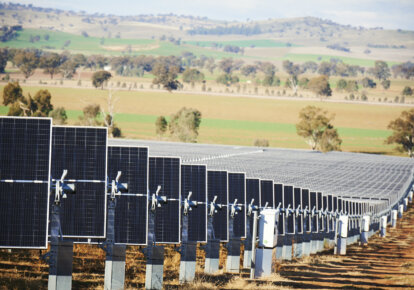For twelve months, the Flow Power true zero working group have been exploring what true zero means – to us, to market stakeholders, and ultimately what the transition to true zero might mean in terms of product and service innovation.
We defined the building blocks and key enablers of true zero and have now turned our attention to putting true zero into practice, in line with our goal to make Flow Power’s head office in Melbourne true zero by the end of 2024.
This first phase of solution demonstration starts with time matching to renewables. By using a combination of real world and modelled experiments we have tested different engineering and financial contract innovations designed to bring down the cost of time matching demand to renewables in real time.
Time matching means ensuring output of renewable generation exactly matches usage in real time. In this blog we step through the work we’ve done in preparation for our time matching demonstration.
The constraints of building an entirely electric load profile with load flex potential
- Our head office uses gas, and while we have discussed electrification with our property manager and landlord, we have had to find a way of progressing our project in advance of any electrification works.
- We have advanced plans for electric vehicle charging, but it will take time before these are installed and generating real data.
- Lastly, we have small, but still important unmetered energy loads (such as hot water and elevators) to consider.
Modelling our solution
We are addressing these constraints by building up an entirely electric load profile using models for thermal energy demand, electric vehicle charging and unmetered loads. Specifically modelled:
- HVAC – All electric heating, ventilation and cooling
- DHW – All electric hot water
- Elevator loads
- EV charging loads
Our modelling considered a combination of factors that impact an office’s electrical load including occupancy, ambient temperature, and behaviour of occupants.
The graph below summarises our average daily load, noting elevator usage is a very small but important load when it comes to time matching.

We validated our load profile against publicly available data, to confirm the load shape is very typical of an office building.
Time matching to a modelled load shape
After developing this hypothetical load profile, we modelled a variety of combined solar and battery energy storage systems (BESS) to understand the amount of renewable generation assets that would be required to cover different thresholds of annual load.
The idea here was to essentially ‘force’ time matching to renewables with no or limited load shaping from our site, to arrive at a worst-case size and cost estimate for a time-matched renewable generation asset.
The results create a feel for how difficult reaching time matching will be without any load shaping – achieving close to 100% time matching requires a massively oversized solar and BESS system, with battery utilisation at only 32% and solar utilisation at only 26%.
Even this inefficiently oversized system would see us fall fractionally short of our goal. The following table summarises key modelling results:
| System | 1 | 2 | 3 | 4 | 5 |
| Solar system size | 200kWp | 250kWp | 300kWp | 350kWp | 600kWp |
| Battery size | 150kWh/ 75kW | 200kWh/ 100kW | 200kWh/ 100kW | 300kWh/ 150kW | 600kWh/ 300kW |
| Solar utilisation | 61% | 53% | 46% | 42% | 26% |
| Battery utilisation | 70% | 69% | 74% | 58% | 32% |
| Percentage of load covered | 78.6% | 86.4% | 89.7% | 94.7% | 99.5% |
| Percentage of load covered after load shifting | 80% | 87.8% | 91.1% | 95.1% | 99.6% |
| Percentage of load covered after nighttime load reduced by 50% | 85.4% | 91.3% | 94.2% | 96.8% | 99.8% |
| Percentage of load covered after nighttime load reduced by 100% | 88.9% | 93.8% | 96.2% | 98.1% | 100% |
Getting from 95%-to-100% coverage presents the greatest challenge. This is because the overnight and morning loads, especially in winter, require significantly oversized assets to guarantee coverage for those periods where the solar generation is consistently low. It’s also due to the inconsistency of weather patterns. There are a few days each year where consistently low solar presents issues even using really large solar and BESS systems.
Early findings of load shifting
By doing simple load shifting, such as moving EV charging to full capacity from 12pm to 3:30pm and delaying HVAC ramp up in the mornings and ramping down earlier in the afternoon, the smaller systems’ (numbers 1, 2, and 3 in our modelling) load coverage improves by only 1.4% and for the higher coverage systems (4, 5) the improvement is minimal. The above table shows the changes. Since the typical office load profile is already a good match to a solar generation profile, shifting these HVAC and EV charging loads had less impact than we might expect.
There would likely be benefit to using a combination of wind, solar, and BESS, but the final ~5% of load coverage by renewables is going to be the hardest part to solve as demonstrated by the size difference between systems 4 and 5. We need almost double the system size to go from 95% to 100% coverage. The cost of system 5 is also 3 times the cost of system 1, with only 20% more load coverage. The biggest overall impact would come from minimising the overnight loads, which presents a new challenge for us in figuring out whether this can be done practically in the office.
In simulations, reducing the overnight (between 6pm and 7am) loads by 50% improved our coverage significantly, as shown in the previous table. Reducing the nighttime loads by 100% however, gave us our first simulated run that hit true zero! Between load shifting, and 100% overnight load shedding, system 1 went from covering less than 80% of the load, to almost 90%.
By combining load shifting, load shedding, solar and BESS, true zero is within our sights. If we then also added wind generation for the winter months, this could mean a good reduction in required size for the solar and BESS system, and therefore a more practical and cost-effective solution.
Next steps: time matching to renewables for real
We are currently setting up a live data feed connecting our head office to one of our solar and BESS assets. This will give us the ability to control that asset and match supply to the office load profile. During these explorations, we will also start to formulate what a new Power Purchase Agreement under this framework could look like and cost a consumer.
We will also setup an augmented load profile, taking our live data feed, but adding in the theoretical electrical loads (all electric HVAC, unmetered load, hot water and EV charging) and control the BESS to this augmented load profile. This will give us a testing environment to see the impact load flexing has on time matching in real time.
We will also investigate what loads run through the night, given the significant impact this has on the cost of time matching. We’re also interested in the potential for purchasing a ‘fractional PPA’, where we buy a fixed percentage of wind generation but only for 4 months from May to August. This winter period is where our solar and BESS system falls short so supplementing with wind could be the key to reaching true zero.
Join us on the road to true zero
Is your business ready to think beyond net zero?
Get in touch with our team to discuss how we can support your journey today.














